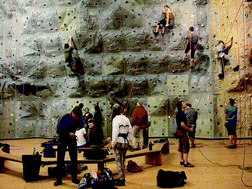The use of hydrated magnesium carbonate hydroxide (magnesia alba) for drying the hands is a strong source for particulate matter in indoor climbing halls. Particle mass concentrations (PM10, PM2.5 and PM1) were measured with an optical particle counter in 9 indoor climbing halls and in 5 sports halls. Mean values for PM10 in indoor climbing halls are generally on the order of 200–500 μg m−3. For periods of high activity, which last for several hours, PM10 values between 1000 and 4000 μg m−3 were observed. PM2.5 is on the order of 30–100 μg m−3 and reaches values up to 500 μg m−3, if many users are present. In sports halls, the mass concentrations are usually much lower (PM10 < 100 μg m−3, PM2.5 ≤ 20 μg m−3). However, for apparatus gymnastics (a sport in which magnesia alba is also used) similar dust concentrations as for indoor climbing were observed. The size distribution and the total particle number concentration (3.7 nm–10 μm electrical mobility diameter) were determined in one climbing hall by an electrical aerosol spectrometer. The highest number concentrations were between 8000 and 12 000 cm−3, indicating that the use of magnesia alba is no strong source for ultrafine particles. Scanning electron microscopy and energy-dispersive X-ray microanalysis revealed that virtually all particles are hydrated magnesium carbonate hydroxide. In-situ experiments in an environmental scanning electron microscope showed that the particles do not dissolve at relative humidities up to 100%. Thus, it is concluded that solid particles of magnesia alba are airborne and have the potential to deposit in the human respiratory tract. The particle mass concentrations in indoor climbing halls are much higher than those reported for schools and reach, in many cases, levels which are observed for industrial occupations. The observed dust concentrations are below the current occupational exposure limits in Germany of 3 and 10 mg m−3 for respirable and inhalable dust. However, the dust concentrations exceed the German guide lines for work places without use of hazardous substances. In addition, minimizing dust concentrations to technologically feasible values is required by the current German legislation. Therefore, substantial reduction of the dust concentration is required.

You have access to this article
 Please wait while we load your content...
Something went wrong. Try again?
Please wait while we load your content...
Something went wrong. Try again?


 Please wait while we load your content...
Please wait while we load your content...